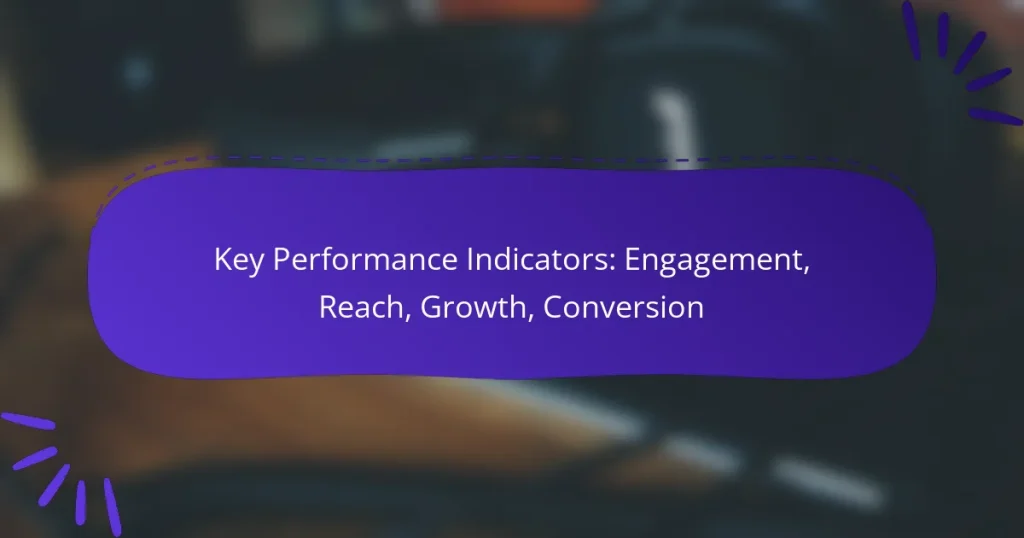Key Performance Indicators (KPIs) are essential for evaluating the effectiveness of e-commerce strategies, focusing on metrics such as engagement, reach, growth, and conversion. By measuring how users interact with content, the total audience exposure, and overall business performance, companies can gain valuable insights to optimize their marketing efforts and drive profitability.

How to measure engagement in e-commerce?
Measuring engagement in e-commerce involves tracking how users interact with your site and content. Key metrics include session duration, pages viewed, bounce rates, and social media interactions, all of which provide insights into customer behavior and preferences.
Average session duration
Average session duration indicates how long visitors stay on your site during a single visit. A longer duration typically suggests that users find your content engaging and relevant. Aim for an average session duration of at least 2-3 minutes, but this can vary by industry.
To improve this metric, focus on providing valuable content, optimizing site speed, and ensuring a user-friendly navigation experience. Regularly analyze this data to identify trends and adjust your strategies accordingly.
Pages per session
Pages per session measures the average number of pages viewed during a single visit. Higher numbers indicate that users are exploring your site and engaging with multiple products or content pieces. Aiming for 3-5 pages per session is often a good benchmark.
To increase this metric, consider implementing related product suggestions, internal linking strategies, and engaging content that encourages users to explore further. Monitor this metric to understand what content keeps users interested.
Bounce rate
Bounce rate represents the percentage of visitors who leave your site after viewing only one page. A lower bounce rate is generally better, indicating that users are finding what they need and continuing to explore. A bounce rate below 40% is often considered healthy.
To reduce bounce rates, ensure your landing pages are relevant to the traffic source, improve load times, and create compelling calls to action. Regularly review bounce rates for different pages to identify areas for improvement.
Social media interactions
Social media interactions encompass likes, shares, comments, and overall engagement with your brand on platforms like Facebook, Instagram, and Twitter. High interaction rates can enhance brand visibility and drive traffic to your e-commerce site.
To boost social media engagement, share valuable content, run interactive campaigns, and encourage user-generated content. Track these interactions to understand what resonates with your audience and adjust your strategy accordingly.
Email open rates
Email open rates measure the percentage of recipients who open your marketing emails. A higher open rate indicates effective subject lines and relevant content. Aiming for an open rate of 15-25% is common in e-commerce.
To improve open rates, segment your email lists, personalize content, and optimize send times based on your audience’s behavior. Regularly analyze open rates to refine your email marketing strategy and increase engagement.

What is reach and why does it matter?
Reach refers to the total number of unique individuals who see your content, making it a crucial metric for understanding your audience’s exposure. It matters because higher reach can lead to increased brand awareness, engagement, and ultimately, conversions.
Definition of reach
Reach is defined as the number of distinct users who encounter your content over a specific period. This metric is often used in digital marketing to gauge how far your message travels across various platforms, including social media, websites, and email campaigns.
Understanding reach helps businesses identify their audience size and the effectiveness of their marketing strategies. It is essential for evaluating the potential impact of campaigns and adjusting tactics accordingly.
Impact on brand awareness
Reach directly influences brand awareness by increasing the likelihood that potential customers will recognize and remember your brand. A broad reach means more people are exposed to your messaging, which can enhance familiarity and trust.
For instance, a campaign that reaches thousands of users can create a ripple effect, where increased visibility leads to discussions about the brand, further amplifying its presence in the market. This is particularly vital in competitive industries where standing out is crucial.
Tools for measuring reach
Several tools can help measure reach effectively, including social media analytics platforms, Google Analytics, and email marketing software. These tools provide insights into how many unique users interacted with your content and where they came from.
For example, social media platforms like Facebook and Instagram offer built-in analytics that show reach metrics for posts and ads. Additionally, using UTM parameters in links can help track reach across different channels, allowing for a comprehensive view of audience engagement.

How to track growth in e-commerce?
Tracking growth in e-commerce involves monitoring key metrics that reflect sales performance, customer engagement, and market positioning. By analyzing these indicators, businesses can identify trends, optimize strategies, and enhance profitability.
Year-over-year sales growth
Year-over-year sales growth measures the percentage increase in sales from one year to the next. This metric provides a clear picture of how well a business is performing over time, allowing for comparisons against industry benchmarks.
To calculate this, subtract last year’s sales from this year’s sales, divide by last year’s sales, and multiply by 100. For example, if last year’s sales were $100,000 and this year’s are $120,000, the growth rate is 20%.
Customer acquisition rate
The customer acquisition rate indicates how effectively a business is gaining new customers. This metric is crucial for understanding the effectiveness of marketing strategies and overall business growth.
To calculate this rate, divide the number of new customers acquired during a specific period by the total number of potential customers during that same period, then multiply by 100. A typical target might be to acquire 5-10% of your target market annually.
Market share analysis
Market share analysis assesses a company’s sales as a percentage of the total market sales. This metric helps businesses understand their competitive position within the industry and identify growth opportunities.
To calculate market share, divide your company’s sales by the total sales of the industry and multiply by 100. For example, if your sales are $200,000 and the total market sales are $2,000,000, your market share is 10%.

What are effective conversion metrics?
Effective conversion metrics are key indicators that help businesses assess the success of their marketing strategies in turning potential customers into actual buyers. These metrics provide insights into customer behavior and the overall effectiveness of sales funnels.
Conversion rate optimization
Conversion rate optimization (CRO) involves improving the percentage of visitors who complete a desired action on a website, such as making a purchase or signing up for a newsletter. To optimize conversion rates, businesses should analyze user behavior, test different website elements, and refine their messaging.
Common strategies include A/B testing, enhancing user experience, and ensuring that calls-to-action are clear and compelling. A well-optimized conversion rate can range from 1% to 5%, depending on the industry and target audience.
Cart abandonment rate
The cart abandonment rate measures the percentage of shoppers who add items to their online shopping cart but leave the site without completing the purchase. This metric is crucial for understanding potential barriers in the buying process.
To reduce cart abandonment, businesses can simplify the checkout process, provide clear shipping information, and send follow-up emails to remind customers of their abandoned carts. Typical cart abandonment rates can vary widely, often falling between 60% and 80% across different sectors.
Return on ad spend (ROAS)
Return on ad spend (ROAS) is a metric that evaluates the revenue generated for every dollar spent on advertising. It helps businesses determine the effectiveness of their advertising campaigns and allocate budgets more efficiently.
A good ROAS typically ranges from 4:1 to 10:1, meaning that for every dollar spent, the business earns four to ten dollars in revenue. To improve ROAS, focus on targeting the right audience, optimizing ad creatives, and continuously analyzing campaign performance.

How do engagement and conversion relate?
Engagement and conversion are closely linked; higher engagement often leads to increased conversion rates. When users interact meaningfully with content, they are more likely to take desired actions, such as making a purchase or signing up for a newsletter.
Engagement leading to conversions
Engagement can take many forms, including likes, shares, comments, and time spent on a website. The more engaged a user is, the more likely they are to trust the brand and convert. For instance, a user who spends several minutes reading a blog post is more inclined to click on a product link within that content.
To enhance engagement, consider using interactive elements like polls or quizzes, which can keep users on your site longer. Additionally, personalized content that resonates with the audience’s interests can significantly boost engagement and, consequently, conversion rates.
Case studies of successful campaigns
Many brands have successfully leveraged engagement to drive conversions. For example, a well-known e-commerce site increased its conversion rate by 30% after implementing a user-generated content strategy, encouraging customers to share their experiences and photos with products.
Another case involved a social media campaign where a company used engaging videos to explain product benefits. This approach led to a significant rise in both engagement metrics and conversions, demonstrating the effectiveness of combining compelling content with clear calls to action.

What frameworks help evaluate KPIs?
Frameworks for evaluating Key Performance Indicators (KPIs) provide structured methods to assess performance metrics effectively. Utilizing these frameworks helps organizations align their goals with measurable outcomes, ensuring a clear path to achieving strategic objectives.
SMART criteria for KPI selection
The SMART criteria stand for Specific, Measurable, Achievable, Relevant, and Time-bound. This framework ensures that each KPI is clearly defined and can be tracked over time, making it easier to assess progress and success. For example, instead of saying “increase sales,” a SMART KPI would be “increase sales by 15% over the next quarter.”
When selecting KPIs using SMART, consider the specific outcomes you want to achieve and ensure they are realistic within your resources and timeframe. Avoid vague objectives; clarity in what you want to measure is essential for effective tracking.
Balanced scorecard approach
The balanced scorecard approach evaluates performance from multiple perspectives: financial, customer, internal processes, and learning and growth. This holistic view allows organizations to understand how well they are achieving their strategic goals beyond just financial metrics. For instance, a company might track customer satisfaction alongside revenue growth.
Implementing a balanced scorecard involves identifying key metrics in each perspective and linking them to strategic objectives. Regularly reviewing these metrics can help organizations adjust strategies as needed, ensuring a comprehensive understanding of performance across various dimensions.


